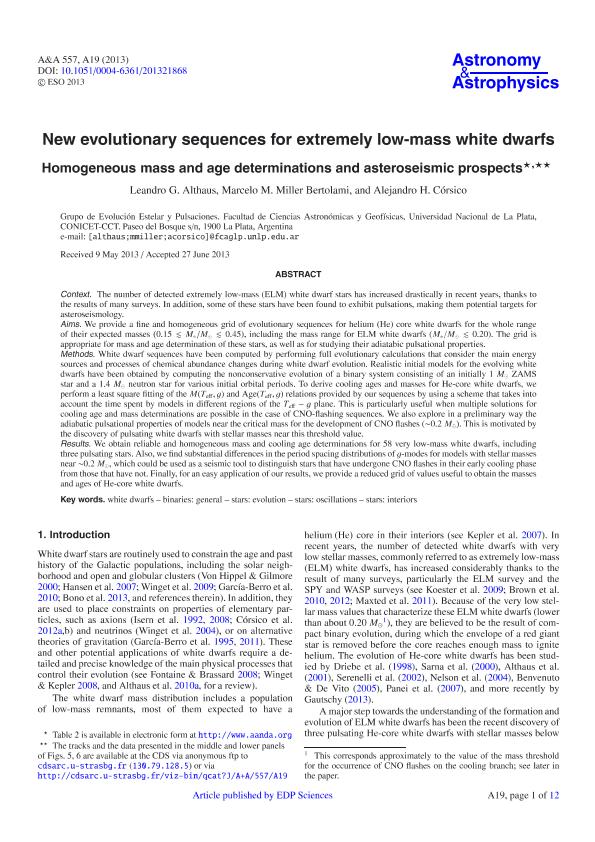Mostrar el registro sencillo del ítem
dc.contributor.author
Althaus, Leandro Gabriel

dc.contributor.author
Miller Bertolami, Marcelo Miguel

dc.contributor.author
Corsico, Alejandro Hugo

dc.date.available
2016-11-23T15:22:07Z
dc.date.issued
2013-09
dc.identifier.citation
Althaus, Leandro Gabriel; Miller Bertolami, Marcelo Miguel; Corsico, Alejandro Hugo; New evolutionary sequences for extremely low-mass white dwarfs: Homogeneous mass and age determinations and asteroseismic prospects; Edp Sciences; Astronomy And Astrophysics; 557; 19; 9-2013; 1-12
dc.identifier.issn
0004-6361
dc.identifier.uri
http://hdl.handle.net/11336/8292
dc.description.abstract
Context. The number of detected extremely low-mass (ELM) white dwarf stars has increased drastically in recent years, thanks to the results of many surveys. In addition, some of these stars have been found to exhibit pulsations, making them potential targets for asteroseismology. Aims. We provide a fine and homogeneous grid of evolutionary sequences for helium (He) core white dwarfs for the whole range of their expected masses (0.15 M∗/M 0.45), including the mass range for ELM white dwarfs (M∗/M 0.20). The grid is appropriate for mass and age determination of these stars, as well as for studying their adiatabic pulsational properties. Methods. White dwarf sequences have been computed by performing full evolutionary calculations that consider the main energy sources and processes of chemical abundance changes during white dwarf evolution. Realistic initial models for the evolving white dwarfs have been obtained by computing the nonconservative evolution of a binary system consisting of an initially 1 M ZAMS star and a 1.4 M neutron star for various initial orbital periods. To derive cooling ages and masses for He-core white dwarfs, we perform a least square fitting of the M(Teff, g) and Age(Teff, g) relations provided by our sequences by using a scheme that takes into account the time spent by models in different regions of the Teff − g plane. This is particularly useful when multiple solutions for cooling age and mass determinations are possible in the case of CNO-flashing sequences. We also explore in a preliminary way the adiabatic pulsational properties of models near the critical mass for the development of CNO flashes (∼0.2 M ). This is motivated by the discovery of pulsating white dwarfs with stellar masses near this threshold value. Results. We obtain reliable and homogeneous mass and cooling age determinations for 58 very low-mass white dwarfs, including three pulsating stars. Also, we find substantial differences in the period spacing distributions of g-modes for models with stellar masses near ∼0.2 M , which could be used as a seismic tool to distinguish stars that have undergone CNO flashes in their early cooling phase from those that have not. Finally, for an easy application of our results, we provide a reduced grid of values useful to obtain the masses and ages of He-core white dwarfs.
dc.format
application/pdf
dc.language.iso
eng
dc.publisher
Edp Sciences

dc.rights
info:eu-repo/semantics/openAccess
dc.rights.uri
https://creativecommons.org/licenses/by/2.5/ar/
dc.subject
White Dwarfs
dc.subject
Binaries
dc.subject
Evolution of Stars
dc.subject
Oscillations
dc.subject
Interiors Stars
dc.subject.classification
Astronomía

dc.subject.classification
Ciencias Físicas

dc.subject.classification
CIENCIAS NATURALES Y EXACTAS

dc.title
New evolutionary sequences for extremely low-mass white dwarfs: Homogeneous mass and age determinations and asteroseismic prospects
dc.type
info:eu-repo/semantics/article
dc.type
info:ar-repo/semantics/artículo
dc.type
info:eu-repo/semantics/publishedVersion
dc.date.updated
2016-11-18T15:11:16Z
dc.journal.volume
557
dc.journal.number
19
dc.journal.pagination
1-12
dc.journal.pais
Francia

dc.journal.ciudad
Paris
dc.description.fil
Fil: Althaus, Leandro Gabriel. Consejo Nacional de Investigaciones Científicas y Técnicas. Centro Científico Tecnológico la Plata. Instituto de Astrofísica de la Plata; Argentina. Universidad Nacional de la Plata. Facultad de Ciencias Astronómicas y Geofísicas; Argentina
dc.description.fil
Fil: Miller Bertolami, Marcelo Miguel. Consejo Nacional de Investigaciones Científicas y Técnicas. Centro Científico Tecnológico la Plata. Instituto de Astrofísica de la Plata; Argentina. Universidad Nacional de la Plata. Facultad de Ciencias Astronómicas y Geofísicas; Argentina
dc.description.fil
Fil: Corsico, Alejandro Hugo. Consejo Nacional de Investigaciones Científicas y Técnicas. Centro Científico Tecnológico la Plata. Instituto de Astrofísica de la Plata; Argentina. Universidad Nacional de la Plata. Facultad de Ciencias Astronómicas y Geofísicas; Argentina
dc.journal.title
Astronomy And Astrophysics

dc.relation.alternativeid
info:eu-repo/semantics/altIdentifier/url/http://www.aanda.org/articles/aa/abs/2013/09/aa21868-13/aa21868-13.html
dc.relation.alternativeid
info:eu-repo/semantics/altIdentifier/doi/http://dx.doi.org/10.1051/0004-6361/201321868
Archivos asociados
